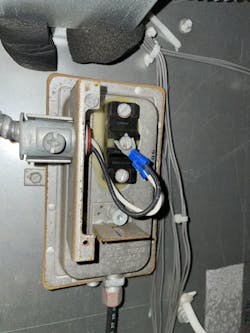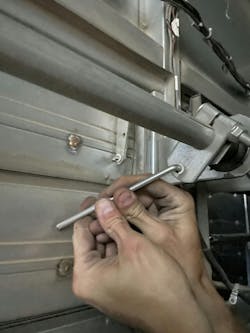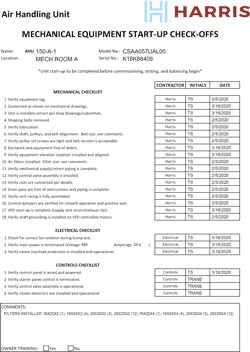Building Commissioning Deepens Trust and Proves Value
Required by most manufacturers alongside start-up, commissioning is about making sure equipment is functioning as designed and per manufacturer and/or engineer specifications. Reports need to be completed and paperwork must be submitted correctly. If that’s as deep as the conversation goes, commissioning can feel like it’s just the last box you check before closing up and moving on.
That line of thinking is how we end up with clients (usually on smaller jobs with tighter budgets) who erroneously believe that installation is good enough. The equipment is installed and the “disconnect” switch is closed, so surely the lowest bid will suffice.
Every Project Will Have an Issue
Here’s the thing: commissioning really isn’t about discovering IF there are problems. It’s about finding out how many there are and fixing them. Today’s buildings (not unlike today’s cars, computers, phones, etc.) are more advanced than ever and with new technology emerging almost daily, they’re getting more intricate and complex by the minute. Considering that alongside the fact that these projects involve the work of many entities spanning multiple trades, it’s hard to envision any project, no matter how small, not encountering issues here and there.
This doesn’t just apply to huge projects with lots of complexity and moving parts. It happens on the so-called easy jobs as well. Take for example a job we performed at a laboratory building that recently installed new solar panels and rooftop units. The solar panel company the customer hired coordinated installation with a different contractor. Sometime later, they started having trouble regulating temperatures, and when the installation contractor couldn’t find a solution, Harris, who’d been servicing the equipment there for years, was called in to assist. When our technicians arrived, they discovered constant volume (CV) units had been installed on the building’s variable air volume (VAV) system. While it’s possible the customer, not knowing the intricacies of their HVAC system, was just looking for the lowest priced equipment “in general,” it’s the responsibility of the contractor to do due diligence. It’s on us to make sure that the equipment is suited to the job. As you can imagine, this scenario involved a lot of headaches for the Owner and resulted in corrective measures and doubtless a loss of credibility for the contractor that originally performed the work.
Reducing Costs
Commissioning only seems expensive when you’re only considering the up-front cost. Effective commissioning will actually reduce operating costs, improve energy efficiency, catch mistakes (sometimes well in advance of close out when commissioning agents are brought in early) and go a long way towards promoting the overall efficacy and longevity of the systems and equipment in a building, not to mention the reduced warranty call-backs that may follow over the next 12 months.
Today’s buildings (not unlike today’s cars, computers, phones, etc.) are more advanced than ever, and with new technology emerging almost daily, they’re getting more intricate and complex by the minute.
Plus, with sustainability a part of almost every conversation these days, commissioning and recommissioning is how buildings meet and maintain building and energy benchmark score standards (also avoiding hefty fees in some regions).
Full Disclosure to the Owner
Getting commissioning right as a contractor comes down to understanding who does the work as much as how to work well alongside them, so we’ll start there.
By the books on most work, a commissioning agent can be either a qualified employee of the owner, an independent third party or subcontractor, a member of the design or construction team (not involved in the design or construction of the project to be commissioned) or a completely independent consultant. It’s not at all uncommon for a representative of the Owner (a contractor, the architect, the project manager, etc.) to solicit bids from potential agents, but the ideal situation would involve the Owner finding and retaining the commissioning agent directly. The imperative here is to ensure the commissioning agent is beholden first and foremost to the Owner, their requirements and their design intent. You want to avoid any bias or conflicts of interest, as only by having a truly independent and objective commissioning agent conducting the work can you be certain the findings reported back to the Owner are thorough, transparent and above all accurate.
As a contractor, this means the commissioning agent is not our friend. Nor should they be. Their job is quality-assurance on top of anything we’ve already done. They’re making sure systems operate correctly, checking the finer details of the construction work and ensuring correct settings, program codes and more. They then write a report that becomes public to all parties with a “punch list” of items that need to be handled. In other words: they’ll air our dirty laundry.
That said, just because the commissioning agent isn’t our friend doesn’t mean they can’t be a valuable ally. Commissioning records are absolutely critical for future service. Having a record that equipment met specifications during commissioning makes it a lot easier to identify issues that happen afterward, whereas without those records pinpointing the cause becomes a nightmare of back and forth with the client trying to diagnose a problem.
It Begins at Start-up
The way we smooth the path for commissioning is through well executed start-up. At Harris, this can look like walking the building to trace piping and ductwork (mapping it, essentially): does the layout make sense, does everything look correct on sight? As an example, recently we had a project that was plan and spec, and during one of these walk-throughs something looked questionable. Upon further investigation it was, in fact, assembled incorrectly. Never doubt the amount of catches a skilled professional can pick up sometimes just by having a look.
Following a visual examination, we move to pre-functional checks to confirm that all equipment and systems are safe to operate, then to functional checks, following behind electricians as they confirm that equipment is ready to be turned on. Ideally, the building automation professionals work alongside us with point-to-point checks as we move throughout the project getting everything up and running, at which point balancing comes in to do their checks. This process gets everything ready so that by the time the commissioning agent arrives on scene, we’ve worked through and addressed as many problems as we can identify beforehand. That translates to fewer mechanical punch list items in their report and ultimately fewer headaches under pressure when the deadline is coming in hot.
Extra 10 Percent
Obviously, the aim of every job, whether it’s for new construction or an existing building, is to get the work done right the first time. The more successful you are, whether that’s as an industry-leading organization or as the best-in-class independent contractor in your area, the easier it is to trust your work so much you stop checking it as often as you once did. Many contractors come in, install the equipment, turn it on and leave, but you cannot oversell the value of putting in an extra 10%. It not only builds, maintains and enhances your reputation as a contractor with unimpeachable capabilities, your relationships with general contractors, clients, subcontractors and even employees within your organization become deeper and more valuable.
Advocating for more quality assurance no matter the size or scope of the project isn’t about your faith in the work or your people’s ability to execute. It comes down to being more committed to getting it right than you are to just getting it done, which is a reputation that will never stop bringing in business.
Ken Berg is Service Pipefitter for HARRIS. Ken has been in the industry for over two decades. His education and training, along with hands-on experience working on a variety of facilities and challenges, make him a valuable team lead. His attention to detail and safety allow him to complete projects on time and on budget.
Christian Desautels is HVACR Service Field Supervisor for Harris. Christian has been with Harris for six years and in the industry for almost twenty. He has extensive experience in the HVAC Service industry and has worked on a variety of products including split systems, industrial air handlers, boilers, chillers and modern VRF/VRV systems in both Canada and the United States. He is well-versed in the basics of building automation systems.
Founded in St. Paul, MN in 1948, Harris designs, build, controls and maintains plumbing, piping, process piping and HVAC systems for commercial, institutional and industrial customers, offering complete Design/Build and Design/Assist services for projects that vary in size, scope and complexity. harriscompany.com
About the Author
Ken Berg
Service Pipefitter
Ken Berg is Service Pipefitter for Harris. Ken has been in the industry for over two decades. His education and training, along with hands-on experience working on a variety of facilities and challenges, make him a valuable team lead. His attention to detail and safety allow him to complete projects on time and on budget.
Christian Desautels
HVACR Service Field Supervisor
Christian Desautels is HVACR Service Field Supervisor for Harris. Christian has been with Harris for six years and in the industry for almost twenty. He has extensive experience in the HVAC Service industry and has worked on a variety of products including split systems, industrial air handlers, boilers, chillers and modern VRF/VRV systems in both Canada and the United States. He is well-versed in the basics of building automation systems. He has extensive experience in the HVAC Service industry and has worked on a variety of products including split systems, industrial air handlers, boilers, chillers and modern VRF/VRV systems in both Canada and the United States. He is well-versed in the basics of building automation systems.





